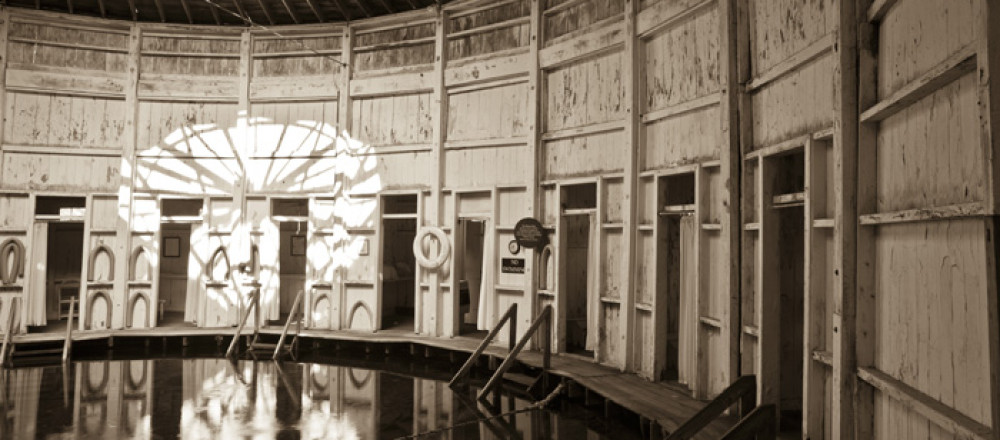A Brief History of Warm Springs, Virginia
Settlement in what we now call “Warm Springs” began in the mid-1700’s. It centered on the natural springs that colonists had discovered while exploring the Virginia frontier. Word spread that the warm waters offered relief from various ailments and soon visitors began to travel to area to “take the waters.”
Recognizing the commercial potential of the area, members of the Lewis family obtained land grants for this section of Augusta County. However, access to the area was limited. In order to get more visitors to the springs, a road was needed. In 1772, the Virginia legislature funded the early turnpike over the mountain to what is now Warm Springs.
Development of the resort quickly followed. The Colonnade Hotel was built by the John and Margaret Lewis adjacent to the Warm Sulphur Springs. A larger hotel later replaced it. This resort soon became the most famous and fashionable of the many springs hotels spread across the spine of the Allegheny mountain range. It was the starting point for the summer social season at the mountain springs.
The hotel grew and prospered throughout the antebellum period with the arrival of the railroad to the Millboro Depot in the 1850s. The hotel was hosting over 6,000 visitors each year. After the Civil War, the Warm Springs Hotel continued to attract Virginians seeking to “take the waters.”
However, the owners of the resort chose not to modernize the hotel. There were no electric lights, no heating (other than fireplaces), no modern plumbing and no telephones. It slowly faded away. In 1924, it was torn down. The old resort property, including the Warm Springs Pools, was acquired by the owners of The Homestead, five miles down the road in Hot Springs. Resorts in Hot Springs and White Sulphur Springs eclipsed “the Warm” as the favored destinations on the summer circuit.
During its heyday, the resort area around the springs was not the place where the employees lived. They instead settled in a small village just west of the resort, called Germantown. The name was given to the area when it was first settled, after the Revolutionary War, by former Hessian prisoners. This is where the tradespeople set up shop. A grist mill was built. Lawyers established their practices there. Taverns provided lodging, food and beverages for the “rougher” crowd of visitors to the area. It became a center for commerce and a community center for County residents. African-American families settled further west in the area now called West Warm Springs.
Soon after the Revolutionary War, seeking more direct control of their local affairs, the Lewises and others began to push for separation from Augusta County. After several failed efforts, the Virginia General Assembly finally approved the new county, appropriately named “Bath.” In 1791, the first County court proceeding was held on the grounds of the Warm Springs Hotel, in the home of “widow” Mrs. Margaret Lewis. “Bath Courthouse” soon became the name to use for the resort area surrounding the springs.
Recognizing that her home was not a suitable site, Mrs. Lewis soon offered two acres of “hotel” land for the construction of a jail and courthouse. This new building served as the center of County government from 1796 through 1842. In 1843, a new courthouse and jail were built there. These two buildings remain today, operating as the Warm Springs Inn.
As the Warm Springs Hotel declined, Germantown was emerging as an active community. In 1908, after much debate, a new courthouse was built in Germantown—effectively moving the community center to the thriving village and away from the resort area. This courthouse was destroyed by fire in 1912 and a replacement was built on it footprint, opening in 1914. This 1914 building continues at the Bath County Courthouse today.
With America’s entry into World War I, Germantown was judged to no longer be a suitable name for the village. It was renamed Warm Springs, now encompassing the old resort area and what had been the village of Germantown.
Much of 1914 Warm Springs remains today. The Bath Houses at the Warm Springs Pools continue to welcome thousands of visitors each year. Gibson Cottage, the old Hotel’s caretaker’s cottage, stands awaiting badly needed restoration. The barns and associated buildings of the old Homestead Dairy have been beautifully rehabilitated. The old grist mill is now home to a restaurant and inn. Oakley Farm sits at the southern edge of the village on the old road to Hot Springs. Mary Johnston’s home, Three Hills, although suffering from neglect, still stands above the village. The old bank building now houses the library. The Historical Society is located in a former law office building. The charming tree-lined Old Germantown Road continues to be the site of some of the village’s oldest structures.
